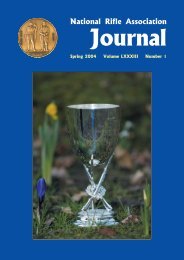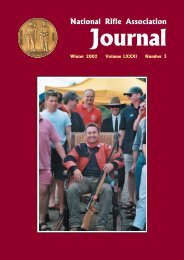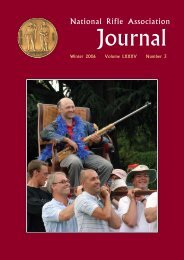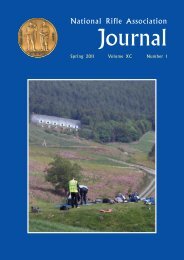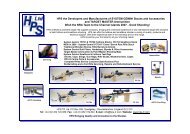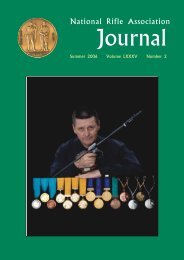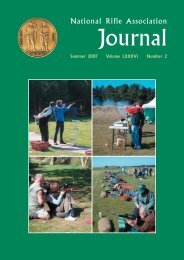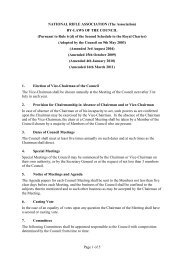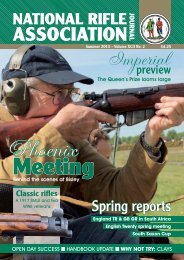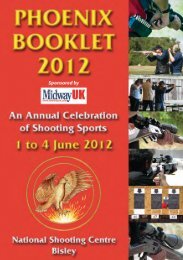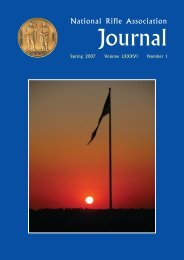NRA Journal - Summer 2003 - National Rifle Association
NRA Journal - Summer 2003 - National Rifle Association
NRA Journal - Summer 2003 - National Rifle Association
- No tags were found...
You also want an ePaper? Increase the reach of your titles
YUMPU automatically turns print PDFs into web optimized ePapers that Google loves.
HM Queen Victoria was dead and her eldest son, HMKing Edward VII, was beginning the third year of hisreign. The third Boer War had ended in 1902 and theBritish public were demanding explanations for theshortcomings of our army exposed by the Boers’irregular fighting force, especially in marksmanship.The Edwardian era was one of fierce pride andpatriotism which stirred the nation out of itscomplacent attitude of comfortable imperialism in theworld. This enthusiasm was reflected in thepopularity of rifle shooting.In 1900, the decision to encourage the activity, by theformation of civilian rifle clubs, had produced nofewer than 343 affiliated clubs by the beginning of 1903and a further 93 joined in that year; the totalmembership now reaching 30,000. At Bisley,Stickledown had doubled its capacity, in time for theImperial Meeting, by increasing the targets from 25 to50.100 YEARS AGOby Ted MolyneuxThe previous year, Great Britain and Ireland had wonthe Palma Match at Rockliffe, near Ottawa, Canada,so, in accordance with the original rules of the match,the <strong>NRA</strong> hosted the 1903 match at Bisley. This tookplace on Saturday 11 July and was won by America,15 points clear of Great Britain in second place.Canada, Australia, Natal, Norway and France alsocompeted and finished in that order. At the time, theAmerican service rifles’ back sight was considered anadvantage, as it was laterally adjustable, a feature soonto be adopted by most nations. It is worthy of notethat the .303" ammunition used by the GB team, wasproduced by the King’s Norton Metal Company witha 220 grains bullet and a slightly larger than standardcordite charge, 215 grains bullet being the regulationservice weight.It was in this year that Captain (later Colonel) Barlowpresented the splendid wrought iron gates whichgraced the entrance to Bisley Camp until taken as rawmaterial for the war effort of World War Two. It alsoA Frith’s series postcard showing the wrought iron gates at themain entrance to Bisley Camp as seen from Queen’s Road.Colour Sergeant WT Davies, winner of the Queen’s Prize 1893and the King’s Prize 1903.saw the introduction of the Astor Challenge trophies,for competition between the clubs of each county, andof the Astor County Championship Cup. Someconcern was shown at the reduction of entries for HMthe King’s Prize, from 1705 to 1530, which was wonfor the second time, by Colour Sergeant Davies, 3rdBattalion Glamorgan Volunteers. His previous winwas in 1893, using a Martini-Henry rifle; this time heused a .303" magazine rifle. He was only the thirdperson to have twice won the Sovereign’s Prize, theother two being Pte Cameron (1866 and 1869) and PteWard (1897 and 1900).Tonbridge won the Ashburton for the first time, fromBradfield, with a new record score of 500 ex 560; 42schools competed. England won the <strong>National</strong> fromWales, Scotland and Ireland in that order, also winningthe Mackinnon from Canada, Australia and Scotland.The visiting Australia team won the Kolapore by 11points from the Mother Country, with Canada, Nataland Guernsey following in that order.Meanwhile, elsewhere, the Suffragette Movement wasfounded by Mrs Emmeline Pankhurst, Orville andWilbur Wright made the first successful flight in apetrol engined aeroplane and the Government rejectedthe idea of imposing fines for drink-driving!49



